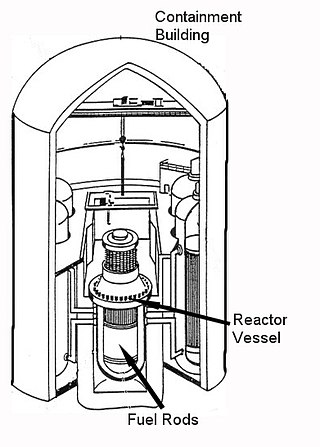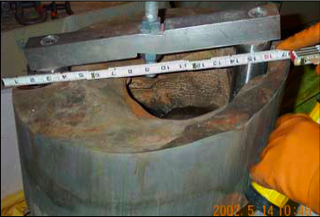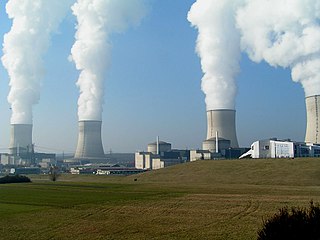
The Three Mile Island accident was a partial nuclear meltdown of the Unit 2 reactor (TMI-2) of the Three Mile Island Nuclear Generating Station on the Susquehanna River in Londonderry Township, near the capital city of Harrisburg, Pennsylvania. The reactor accident began at 4:00 a.m. on March 28, 1979, and released radioactive gases and radioactive iodine into the environment. It is the worst accident in U.S. commercial nuclear power plant history. On the seven-point logarithmic International Nuclear Event Scale, the TMI-2 reactor accident is rated Level 5, an "Accident with Wider Consequences".

A nuclear meltdown is a severe nuclear reactor accident that results in core damage from overheating. The term nuclear meltdown is not officially defined by the International Atomic Energy Agency or by the United States Nuclear Regulatory Commission. It has been defined to mean the accidental melting of the core of a nuclear reactor, however, and is in common usage a reference to the core's either complete or partial collapse.

The Nuclear Regulatory Commission (NRC) is an independent agency of the United States government tasked with protecting public health and safety related to nuclear energy. Established by the Energy Reorganization Act of 1974, the NRC began operations on January 19, 1975, as one of two successor agencies to the United States Atomic Energy Commission. Its functions include overseeing reactor safety and security, administering reactor licensing and renewal, licensing radioactive materials, radionuclide safety, and managing the storage, security, recycling, and disposal of spent fuel.

The H. B. Robinson Steam Electric Plant, also known as Robinson Nuclear Plant, is a nuclear power plant located near Hartsville, South Carolina. The plant consists of one Westinghouse 759 MW pressurized water reactor. The site once included a coal-fired unit that generated 174 MW and a combustion turbine unit that generated 15 MW.

The Byron Nuclear Generating Station is a nuclear power plant located in Ogle County, Illinois, 2 miles (3.2 km) east of the Rock River. The reactor buildings were constructed by Commonwealth Edison and house two Westinghouse Four-Loop pressurized water reactors, Unit 1 and Unit 2, which began operation in September 1985 and August 1987 respectively. The plant is owned and operated by Constellation Energy.

The Robert Emmett Ginna Nuclear Power Plant, commonly known as Ginna, is a nuclear power plant located on the southern shore of Lake Ontario, in the town of Ontario, Wayne County, New York, United States, approximately 20 miles (32 km) east of Rochester, New York. It is a single unit Westinghouse 2-Loop pressurized water reactor, similar to those at Point Beach, Kewaunee, and Prairie Island. Having gone into commercial operation in 1970, Ginna became the second oldest nuclear power reactor, after Nine Mile unit 1, still in operation in the United States when the Oyster Creek power plant was permanently shut down on September 17, 2018.

The Peach Bottom Atomic Power Station is an American nuclear power plant that is located 50 miles (80 km) southeast of Harrisburg in Peach Bottom Township, York County, Pennsylvania. Situated close to the Susquehanna River, it is three miles north of the Maryland border.

Surry Power Station is a nuclear power plant located in Surry County in southeastern Virginia, in the South Atlantic United States. The power station lies on an 840-acre (340 ha) site adjacent to the James River across from Jamestown, slightly upriver from Smithfield and Newport News. Surry is operated by Dominion Generation and owned by Dominion Resources, Inc.

The Enrico Fermi Nuclear Generating Station is a nuclear power plant on the shore of Lake Erie near Monroe, in Frenchtown Charter Township, Michigan on approximately 1,000 acres (400 ha). All units of the plant are operated by the DTE Energy Electric Company and owned by parent company DTE Energy. It is approximately halfway between Detroit, Michigan, and Toledo, Ohio. It is also visible from parts of Amherstburg and Colchester, Ontario as well as on the shore of Lake Erie in Ottawa County, Ohio. Two units have been constructed on this site. The first unit's construction started on August 4, 1956 and reached initial criticality on August 23, 1963, and the second unit received its construction permit on September 26, 1972. It reached criticality on June 21, 1985 and was declared commercial on November 18, 1988. The plant is connected to two single-circuit 345 kV Transmission Lines and three 120 kV lines. They are operated and maintained by ITC Transmission.

A containment building is a reinforced steel, concrete or lead structure enclosing a nuclear reactor. It is designed, in any emergency, to contain the escape of radioactive steam or gas to a maximum pressure in the range of 275 to 550 kPa. The containment is the fourth and final barrier to radioactive release, the first being the fuel ceramic itself, the second being the metal fuel cladding tubes, the third being the reactor vessel and coolant system.
WASH-1400, 'The Reactor Safety Study', was a report produced in 1975 for the Nuclear Regulatory Commission by a committee of specialists under Professor Norman Rasmussen. It "generated a storm of criticism in the years following its release". In the years immediately after its release, WASH-1400 was followed by a number of reports that either peer reviewed its methodology or offered their own judgments about probabilities and consequences of various events at commercial reactors. In at least a few instances, some offered critiques of the study's assumptions, methodology, calculations, peer review procedures, and objectivity. A succession of reports, including NUREG-1150, the State-of-the-Art Reactor Consequence Analyses and others, have carried-on the tradition of PRA and its application to commercial power plants.

Spent fuel pools (SFP) are storage pools for spent fuel from nuclear reactors. They are typically 40 or more feet (12 m) deep, with the bottom 14 feet equipped with storage racks designed to hold fuel assemblies removed from reactors. A reactor's local pool is specially designed for the reactor in which the fuel was used and is situated at the reactor site. Such pools are used for short-term cooling of the fuel rods. This allows short-lived isotopes to decay and thus reduces the ionizing radiation and decay heat emanating from the rods. The water cools the fuel and provides radiological protection from its radiation.

The Price-Anderson Nuclear Industries Indemnity Act is a United States federal law, first passed in 1957 and since renewed several times, which governs liability-related issues for all non-military nuclear facilities constructed in the United States before 2026. The main purpose of the Act is to partially compensate the nuclear industry against liability claims arising from nuclear incidents while still ensuring compensation coverage for the general public. The Act establishes a no fault insurance-type system in which the first approximately $15 billion is industry-funded as described in the Act. Any claims above the $15 billion would be covered by a Congressional mandate to retroactively increase nuclear utility liability or would be covered by the federal government. At the time of the Act's passing, it was considered necessary as an incentive for the private production of nuclear power — this was because electric utilities viewed the available liability coverage as inadequate.
WASH-740 was a report published by the U.S. Atomic Energy Commission (USAEC) in 1957. This report, called "Theoretical Possibilities and Consequences of Major Accidents in Large Nuclear Power Plants", estimated maximum possible damage from a meltdown with no containment building at a large nuclear reactor.
NUREG-1150 "Severe Accident Risks: An Assessment for Five U.S. Nuclear Power Plants", published December 1990 by the Nuclear Regulatory Commission (NRC) is a follow-up to the WASH-1400 and CRAC-II safety studies that employs the methodology of plant-specific Probabilistic Risk Assessment (PRA). The research team, led by Denwood Ross, Joseph Murphy, and Mark Cunningham, concluded that the current generation of nuclear power plants exceeded NRC safety goals.

A nuclear flask is a shipping container that is used to transport active nuclear materials between nuclear power station and spent fuel reprocessing facilities.

Nuclear safety in the United States is governed by federal regulations issued by the Nuclear Regulatory Commission (NRC). The NRC regulates all nuclear plants and materials in the United States except for nuclear plants and materials controlled by the U.S. government, as well those powering naval vessels.
The State-of-the-Art Reactor Consequence Analyses (SOARCA) is a study of nuclear power plant safety conducted by the Nuclear Regulatory Commission. The purpose of the SOARCA is assessment of possible impact on population caused by major radiation accidents that might occur at NPPs. This new study updates older studies with the latest state-of-the-art computer models and incorporates new plant safety and security enhancements.

The United States Government Accountability Office reported more than 150 incidents from 2001 to 2006 of nuclear plants not performing within acceptable safety guidelines. According to a 2010 survey of energy accidents, there have been at least 56 accidents at nuclear reactors in the United States. The most serious of these was the Three Mile Island accident in 1979. Davis-Besse Nuclear Power Plant has been the source of two of the top five most dangerous nuclear incidents in the United States since 1979. Relatively few accidents have involved fatalities.

Nuclear power plants pose high risk if chemicals are exposed to those in surrounding communities and areas. This nuclear emergency level classificationresponse system was firstly developed by the US Nuclear Regulatory Commission to allow effective and urgent responses to ultimately control and minimise any detrimental effects that nuclear chemicals can have. These classifications come in four different categories – Unusual Event, Alert, Site Area Emergency (SAE), as well as General Emergency. Thus, each classification has differing characteristics and purposes, depending on the situation at hand. Every nuclear power plant has a different emergency response action plan, also depending on its structure, location and nature. They were developed by thorough discussion and planning with numerous authoritative parties such as local, state, federal agencies as well as other private and non-profit groups that are in association with emergency services. Today, nuclear emergency plans are continuously being developed over time to be improved for future serious events to keep communities and nuclear power plant working members safe. There is a high emphasis for the need of these emergency responses in case of future events. Thus, nuclear plants can, and have paid up to approximately $78 million to ensure that are required measurements are readily available, and that equipment is sufficient and safe. This is applicable for all nuclear power plants in the United States of America.















